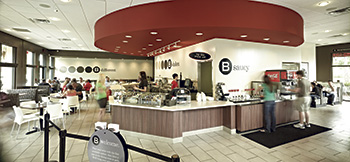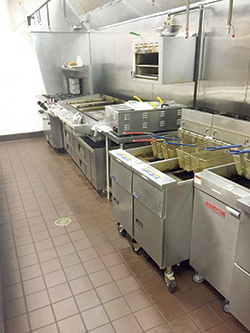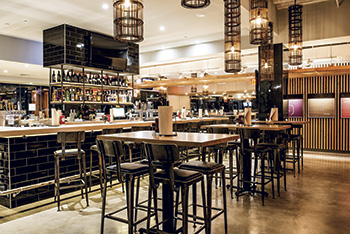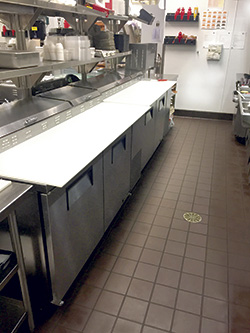Despite the well-documented troubles some of the larger chains continue to experience, consumers’ appetites for burgers remain as strong as ever. The key to success in this crowded and competitive segment is an evolving menu that features high-quality ingredients, paired with a versatile equipment package that brings these flavors to life. Here we look at two operators who continue to accomplish this.
Case Study: Burger 21, Tampa, Fla.
 Burger 21 continues to explore new format options, like a large-scale standalone unit and aiport locations, in addition to the standard prototype seen here.The past few years have been transformative for Burger 21.
Burger 21 continues to explore new format options, like a large-scale standalone unit and aiport locations, in addition to the standard prototype seen here.The past few years have been transformative for Burger 21.
Not only does this growing chain continue to tap new markets, it is also implementing and exploring a pair of format changes. “One thing we’ve tried to do is stay true to who we are in terms of our culture and quality,” says corporate chef Mike Remes. “The goal has been to take what works and transfer it to other business models.”
This includes creating the restaurant’s first stand-alone location, a larger-scale Burger 21 model that will open in Ocala, Fla., in the coming months. The format incorporates another first, a full-service liquor bar, which will help the operation better compete in urban markets. “Liquor is evolving into burger segments,” Remes says. “Because our concept is flexible, our playground is wide open; we’re not restricted to residential areas.”
The new model will expand the menu to include new appetizers and different types of burgers that pair with specialty and craft cocktails. “We have a great support team that makes these new projects streamlined and easier for us to execute,” Remes says.
In addition to expanding its format to accommodate full-service bars, Burger 21 continued to explore opportunities in airport locations. This will allow the chain to enter the lucrative breakfast daypart. “Because of the larger square footage our concept and model currently operates in, we’ll have to scale down our size and condense the menu to take advantage of this market,” says Remes.
 Burger 21’s cookline consists of flattop griddles and fryers, with separate equipment designated to prepare gluten-free items.Although the airport format is in the beginning stages, talks have centered around how the chain will streamline this menu to include burgers and other items high in its product mix alongside breakfast-themed sandwiches. The timeline for this expansion hinges on the construction and scale of the projects, but Remes predicts bids will be in by the end of the year. “The locations are still in development, but definitely in the pipeline,” he adds.
Burger 21’s cookline consists of flattop griddles and fryers, with separate equipment designated to prepare gluten-free items.Although the airport format is in the beginning stages, talks have centered around how the chain will streamline this menu to include burgers and other items high in its product mix alongside breakfast-themed sandwiches. The timeline for this expansion hinges on the construction and scale of the projects, but Remes predicts bids will be in by the end of the year. “The locations are still in development, but definitely in the pipeline,” he adds.
These changes are par for the course for this modern, fast-casual concept, which was created in 2009 by Mark Johnston and his wife Arlene, along with Mark’s brothers Bob and Mike, owners of The Melting Pot restaurant chain. The burgeoning chain, which opened its first location in the Westchase area of Tampa, Fla., in November 2010, now encompasses four corporate-owned sites in the Tampa area, in addition to franchised locations across Florida, New Jersey, New York, North Carolina, Virginia, Georgia and Arizona. Restaurants also are currently in development with franchisees in Chicago and Dallas. In addition, Burger 21 has signed on franchisees in Austin and McAllen, Texas, a new market for the chain.
“In the last three years, Burger 21 has made great strides in expanding its footprint outside of its hometown of Tampa,” says Ashley Pollard, the chain’s director of franchise development.
As the name implies, the menu centers around 21 burgers, which include 10 certified Angus beef options and 10 non-beef varieties, including chicken, turkey, vegetarian, shrimp and ahi tuna. Paying homage to the beef quality and ingredients used in its dishes, the chain’s current focus is on getting back to the basics. “We don’t want customers to be overwhelmed with too many toppings or ingredients, but rather let our Angus beef stand on its own,” Remes says. “This has become even more important recently due to the high price of beef.”
This does not mean the chain has forsaken incorporating recent trends with its menu development. For example, in response to the fervor around spice, Burger 21 created its Tex-Mex Haystack with lettuce, tomato, applewood-smoked bacon, Gouda, guacamole, onion strings and chipotle-jalapeño sauce on a toasted brioche bun. And the chain’s Cinco Burger includes lettuce, tomato, guacamole, salsa, jalapeños, Monterey jack cheese and cilantro cream on a sesame bun. Addressing the popularity of Asian flavors, the chain now offers the Spicy Thai Shrimp Burger with fried shrimp, lettuce, tomato, sriracha aioli, hot chili slaw and sriracha on a toasted sesame bun.
 Grub Burger features a warm and industrial yet polished appearance.With the increased focus on gluten and in response to more customer requests, Burger 21 now offers gluten-free buns for its beef burgers. Menu offerings also include hot dogs, salads and sliders, in addition to chicken tenders, fries and chili. “Based on an online audit of 18 better-burger
Grub Burger features a warm and industrial yet polished appearance.With the increased focus on gluten and in response to more customer requests, Burger 21 now offers gluten-free buns for its beef burgers. Menu offerings also include hot dogs, salads and sliders, in addition to chicken tenders, fries and chili. “Based on an online audit of 18 better-burger
franchises, Burger 21 was found to offer a significantly higher variety in its menu offerings across multiple menu categories,” Pollard says.
Although the menu remains consistent, the layout and aesthetics at each location vary, depending on the location and market. Currently, sites total between 2,200 and 3,000 square feet, with one-third of each space designated to the back of house. The cookline and equipment lineup are uniform at each site. This allows the chain to test new recipes and roll out items at each location without any variances.
As its menu and layout continue to evolve, so too does Burger 21’s equipment package. In recent years, equipment has been streamlined as much as possible to maximize back-of-house space. “With our main equipment, we bid out to multiple national vendors, which is a benefit to our brand as well as the franchisees, since we can lock in the best prices and get national contracts,” Remes says. “When we opened our first locations in Tampa, we had custom equipment, but by franchising we learned to go with stock units to drive operating costs down for franchisees. This has been a big benefit.”
The backbone of Burger 21’s cookline consists of flattop griddles and fryers. Over the last two years, separate equipment has been brought in to prepare gluten-free items. “We recently replaced our convection ovens and fryers with more energy-efficient models that offer a quicker recovery time for peak hours of the day,” Remes says. “As far as our equipment and production, we have learned, grown and developed from each model,” Remes says.
 The production at Grub Burger Bar centers around the flattop grill, double convection oven and fryers.One of the biggest equipment developments has occurred as a result of Burger 21 venturing into the homemade ice cream business. “About two years ago, we worked with a Tampa company to develop a proprietary ice cream recipe,” Remes says. “Today, about two-thirds of our locations have transitioned into utilizing an ice cream machine positioned at our shake bars.”
The production at Grub Burger Bar centers around the flattop grill, double convection oven and fryers.One of the biggest equipment developments has occurred as a result of Burger 21 venturing into the homemade ice cream business. “About two years ago, we worked with a Tampa company to develop a proprietary ice cream recipe,” Remes says. “Today, about two-thirds of our locations have transitioned into utilizing an ice cream machine positioned at our shake bars.”
Burger 21 can slim down the shake production area for locations with smaller footprints. Incorporating these units has been a win-win, not just due to the improved quality of the chain’s shakes, but also in lowering dairy costs and cutting expenses for franchisees. Handcrafted shakes and floats include signature flavors, such as bananas Foster and crème brûlée, in addition to retro root beer and orange soda floats.
This year, the chain will focus on how to offset rising ingredient costs. In response to the increase in beef prices, Burger 21’s corporate restaurants continue to test different burger sizes, weights and diameters. The expansion mode will continue for the chain in 2015, as franchise opportunities continue to build.
Burger 21 continues to explore new format options, like a large-scale standalone unit and aiport locations, in addition to the standard prototype seen here.
Burger Segment Facts
- For the year ending November 2014, total restaurant visits were up 2 percent and up 3 percent at total quick-service locations, which includes retail, while visits to quick-service burger restaurants were down 4 percent, according to The NPD Group’s CREST report.
- Limited-service burger chains reported sales of more than $72 billion in 2013, with growth of 1.2 percent, according to the 2014 Technomic “Top 500 Chain Restaurant Report.”
- Technomic’s report revealed that limited-service burger units increased by 1 percent to 42,853 locations.
- Quick-service burger chains accounted for $69.7 billion in sales in 2013, with sales volume increasing 0.9 percent, according to Technomic.
- Fast-casual burger chains experienced 10.4 percent growth and $2.4 billion in sales in 2013, according to Technomic.
- Ninety-five percent of all consumers report eating burgers at least monthly in 2012, compared with 91 percent in 2011, according to Technomic’s 2013 “Burger Consumer Trend Report.” More than two-thirds of these burgers are purchased away from home, and nearly two-fifths are purchased at quick-service restaurants.
- The presence of specialty burgers on LSR menus increased by 33 percent from 2012 to 2013, according to Technomic’s “Burger Consumer Trend Report.”
- For 2015, the National Restaurant Association predicts that the popularity of mini burgers and sliders will wane and mushroom-blended burgers will be on the upswing.




